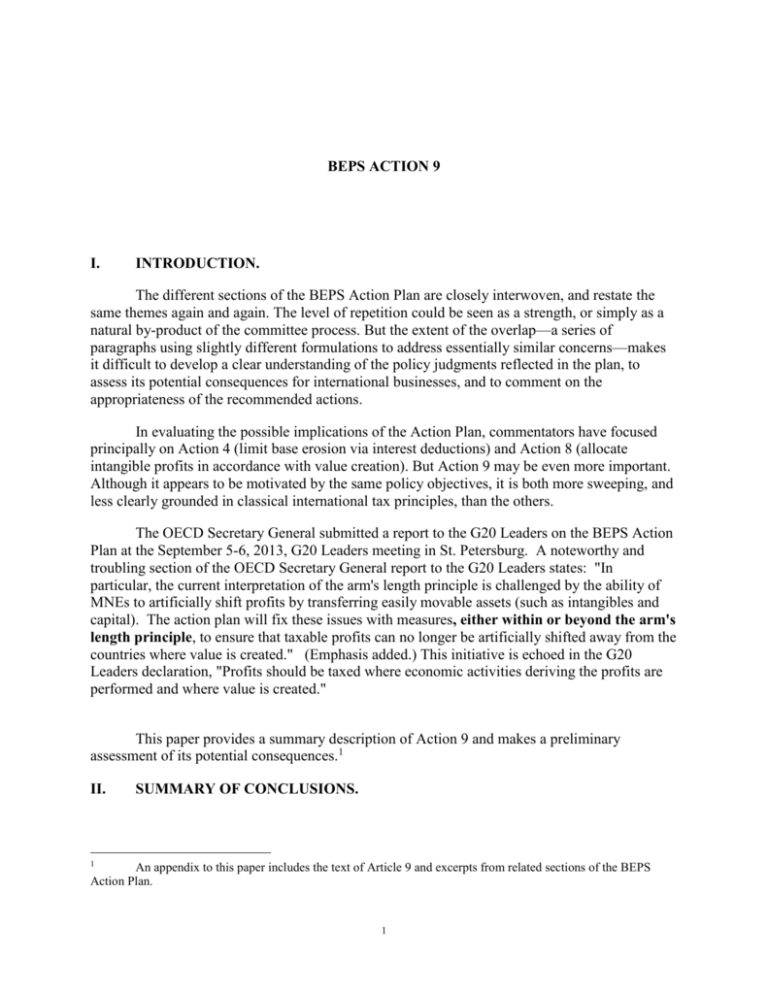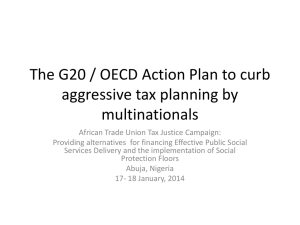Action Item 9 on risks and capital - U.S. Council for International
advertisement

BEPS ACTION 9 I. INTRODUCTION. The different sections of the BEPS Action Plan are closely interwoven, and restate the same themes again and again. The level of repetition could be seen as a strength, or simply as a natural by-product of the committee process. But the extent of the overlap—a series of paragraphs using slightly different formulations to address essentially similar concerns—makes it difficult to develop a clear understanding of the policy judgments reflected in the plan, to assess its potential consequences for international businesses, and to comment on the appropriateness of the recommended actions. In evaluating the possible implications of the Action Plan, commentators have focused principally on Action 4 (limit base erosion via interest deductions) and Action 8 (allocate intangible profits in accordance with value creation). But Action 9 may be even more important. Although it appears to be motivated by the same policy objectives, it is both more sweeping, and less clearly grounded in classical international tax principles, than the others. The OECD Secretary General submitted a report to the G20 Leaders on the BEPS Action Plan at the September 5-6, 2013, G20 Leaders meeting in St. Petersburg. A noteworthy and troubling section of the OECD Secretary General report to the G20 Leaders states: "In particular, the current interpretation of the arm's length principle is challenged by the ability of MNEs to artificially shift profits by transferring easily movable assets (such as intangibles and capital). The action plan will fix these issues with measures, either within or beyond the arm's length principle, to ensure that taxable profits can no longer be artificially shifted away from the countries where value is created." (Emphasis added.) This initiative is echoed in the G20 Leaders declaration, "Profits should be taxed where economic activities deriving the profits are performed and where value is created." This paper provides a summary description of Action 9 and makes a preliminary assessment of its potential consequences.1 II. SUMMARY OF CONCLUSIONS. 1 An appendix to this paper includes the text of Article 9 and excerpts from related sections of the BEPS Action Plan. 1 The BEPS Action Plan disclaims any intention to make changes in the foundational principles of international taxation (as reflected, for example, in the OECD model treaty). Consistently with this disclaimer, many of the recommended actions can be described as a strengthening or modernization of existing rules.2 Action 9 may provide the clearest indication of the extent to which the OECD believes it will be necessary to deviate from classical international tax principles in order to achieve its policy objectives. The stated purpose of Action 9 is to ensure that inappropriate returns will not accrue to an entity solely because it has contractually assumed risks or has provided capital. The description of the proposal doesn’t provide any guidance regarding what considerations will be taken into account in determining whether a return will be considered inappropriate. In particular, the description doesn’t say that: A return on capital will be inappropriate only to the extent it exceeds the amount that would have been payable between unrelated parties dealing at arm’s length; or Compensation for the assumption of risk will be inappropriate only if it exceeds the amount that an unrelated party would have charged, or if the purported assumption of risk is inconsistent with economic reality (for example, because recipient of the compensation doesn’t have the resources to bear, or the capacity to make decisions on whether and how to manage, the risk). Rather, the OECD Secretary General Report on the BEPS Action Plan states that the “action plan will fix these issues with measures, either within or beyond the arm's length principle, to ensure that taxable profits can no longer be artificially shifted away from the countries where value is created." (Emphasis added.) This initiative is echoed in the G20 Leaders declaration, "Profits should be taxed where economic activities deriving the profits are performed and where value is created." Since other portions of the Action Plan deal more directly with the pure transfer pricing issues, it is reasonable to be concerned that Action 9 was intended to apply, at least in some cases, where the compensation payable for the use of capital or the assumption of risk is entirely consistent with arm’s length standards.3 Moreover, the Action Plan appears to confirm that the OECD had a broader objective. The Action Plan says that “there is consensus among governments that moving to a system of formulary apportionment of profits is not a viable way forward.” After reiterating that point, the paragraphs introducing Actions 8, 9 and 10 say that “the best course is to directly address the 2 For example, Actions 1 (tax challenges of the digital economy) and 10 (transfer pricing rules for global value chains) deal with market developments not contemplated by the classical model; Actions 3 (CFC rules) 4 (interest deductions), 8 (intangibles) and 10 (management fees and head office expenses) can be seen as a reinforcement of existing transfer pricing and thin capitalization rules; and Actions 6 (treaty abuse) and 7 (artificial avoidance of PE status) could be described as conventional anti-abuse measures. 3 Other portions of the Action Plan deal with mismatches between income and the costs incurred to earn that income. This again may suggest that the scope of Action 9 is not intended to be limited to the mismatch case. 2 flaws in the current system, in particular with respect to returns related to intangible assets, risk and over-capitalisation. Nevertheless, special measures, either within or beyond the arm’s length principle, may be required with respect to intangible assets, risk and over-capitalisation to address these flaws.” [Emphasis added.] Thus, Action 9, read broadly, could have consequences that are more sweeping, and less grounded in classical international tax principles, than other provisions of the Action Plan. It will be important to determine whether the drafters intended this broad reading, what “special measures…beyond the arm’s length principle” they believe to be necessary, and how policymakers propose to determine whether compensation that is consistent with arm’s length standards nevertheless is inappropriate. III. DISCUSSION AND QUESTIONS. Under current law, companies generally are entitled to make fundamental choices concerning the legal form through which a business activity is conducted and the manner in which that activity is funded.4 Those choices are driven primarily by business (and, where applicable, non-tax regulatory) considerations. For example, the amount of regulatory capital that a bank is required to maintain will depend on considerations including the activities supported by that capital and judgments concerning systemic and entity-level risks. For most regulated businesses, capital is too scarce a resource to be allocated capriciously to produce tax savings. However, in cases where business and regulatory considerations don’t determine the allocation of capital, effective tools are available to protect the fisc: thin capitalization rules, which provide safeguards against base erosion, and controlled foreign corporation (“CFC”) rules, which provide safeguards against profit shifting. Thus, the principle that companies may determine where to conduct activities and how to capitalize them is appropriately limited by CFC and thin capitalization rules. Many tax systems reinforce these rules with further limitations on the ability to transfer profitable activities, or appreciated property, to a foreign country. For example, profitable activities conducted by a U.S. company generally cannot be transferred to a foreign subsidiary without incurring tax costs; further limitations apply to difficult-to-value intangibles; and compensation payable to a foreign subsidiary cannot exceed the amount that would have been payable between unrelated parties. Policymakers, and many taxpayers, believe that these rules have not kept pace with developments in the market, and need to be strengthened or supplemented. But the Action Plan does not provide information sufficient to enable readers to determine whether Action 9 is intended only to patch or reinforce the widely accepted and uncontroversial policies described above, or whether it goes significantly beyond those policies. For example, the arm’s-length standard and transfer pricing rules represent one part of a broad set of rules that are intended to prevent inappropriate tax results. Are the statements that “special measures … beyond the arm’s-length principle” simply intended to reflect this point and suggest that other types of 4 In connection with its codification of the economic substance doctrine, the U.S. Congress recently reaffirmed this longstanding principle, and confirmed that the economic substance doctrine was not intended to apply to fundamental business decisions like the determination whether to conduct activities in a foreign country through a subsidiary or a branch. 3 limitations, such as changes to CFC rules, may be appropriate? Or does the statement express anintent to re-examine the arm’s-length standard? Action 9 is extremely open-ended and extremely vague. In order to give international businesses a meaningful opportunity to review and comment on this aspect of the Action Plan, it is imperative that the OECD provide detailed guidance with respect to the policy concerns that Action 9 is intended to address, the reasons why provisions of the plan dealing with transfer pricing abuses and mismatches between expenses and income are insufficient to address those concerns, the principles that will be applied in determining whether the allocation of capital or risk is inappropriate, and the intended consequences of such a determination. Relevant questions include: Is Article 9 intended as a reexamination of the arm’s-length standard? Or is it intended as an examination of whether measures separate from the arm’s-length standard and transfer pricing principles, such as changes to CFC rules, may be required to address perceived concerns? Under what circumstances will capital held by a foreign subsidiary be considered excessive? Is Action 9 intended to apply only to companies located in tax haven jurisdictions, or could capital held by a group member based in a high-tax jurisdiction be considered excessive? What considerations will determine whether a particular amount of capital is excessive? What considerations will determine whether a particular return on capital is inappropriate? What will be the consequences if the amount of capital, or the return on that capital, is excessive or inappropriate? What considerations will determine whether an allocation or transfer of risk between members of a group is inappropriate? What considerations will determine whether the compensation for bearing a risk is excessive or inappropriate? Is the intention to apply restrictions on the contractual assumption of risk (or on the tax treatment of compensation received for assuming that risk) only to companies located in tax haven jurisdictions that don’t have the financial capacity required to bear, or the capacity to make decisions on whether or how to manage, the risk? 4 If not, under what circumstances could compensation payable to a group member that has such capacity, and that is consistent with arm’s length standards, be considered excessive or inappropriate? What kinds of “special measures” that are “beyond the arm’s length principle” does the Action Plan envision? What policy considerations make those measures appropriate? How will taxpayers and tax administrators be able to determine what they are? 5 Excerpts from the BEPS Action Plan: introductory paragraphs, Action 9 and related commentary Chapter 3 Action Plan Fundamental changes are needed to effectively prevent double non-taxation, as well as cases of no or low taxation associated with practices that artificially segregate taxable income from the activities that generate it. A number of actions can be undertaken in order to address the weaknesses in the current rules in an effective and efficient manner. This Action Plan calls for fundamental changes to the current mechanisms and the adoption of new consensusbased approaches, including anti-abuse provisions, designed to prevent and counter base erosion and profit shifting: New international standards must be designed to ensure the coherence of corporate income taxation at the international level. BEPS issues may arise directly from the existence of loopholes, as well as gaps, frictions or mismatches in the interaction of countries’ domestic tax laws. These types of issues generally have not been dealt with by OECD standards or bilateral treaty provisions. There is a need to complement existing standards that are designed to prevent double taxation with instruments that prevent double non-taxation in areas previously not covered by international standards and that address cases of no or low taxation associated with practices that artificially segregate taxable income from the activities that generate it. Moreover, governments must continue to work together to tackle harmful tax practices and aggressive tax planning. A realignment of taxation and relevant substance is needed to restore the intended effects and benefits of international standards, which may not have kept pace with changing business models and technological developments: Whilst bilateral tax treaties have been effective in preventing double taxation, there is a concern that they often fail to prevent double nontaxation that results from interactions among more than two countries. In particular, the involvement of third countries in the bilateral framework established by treaty partners puts a strain on the existing rules, in particular when done via shell companies that have little or no substance in terms of office space, tangible assets and employees. In the area of transfer pricing, the rules should be improved in order to put more emphasis on value creation in highly integrated groups, tackling the use of intangibles, risks, capital and other high-risk transactions to shift profits. At the same time, there is consensus among governments that moving to a system of formulary apportionment of profits is not a viable way forward; it is also unclear that the behavioural changes companies might adopt in response to the use of a formula would lead to investment decisions that are more efficient and tax-neutral than under a separate entity approach. 6 The actions implemented to counter BEPS cannot succeed without further transparency, nor without certainty and predictability for business. The availability of timely, targeted and comprehensive information is essential to enable governments to quickly identify risk areas. While audits remain a key source of relevant information, they suffer from a number of constraints and from a lack of relevant tools for the early detection of aggressive tax planning. As a result, timely, comprehensive and relevant information on tax planning strategies is often unavailable to tax administrations, and new mechanisms to obtain that information must be developed. At the same time, mechanisms should be implemented to provide businesses with the certainty and predictability they need to make investment decisions. …. A major issue is transfer pricing and the enforcement of the arm’s length principle. Transfer pricing rules serve to allocate income earned by a multinational enterprise among those countries in which the company does business. In many instances, the existing transfer pricing rules, based on the arm’s length principle, effectively and efficiently allocate the income of multinationals among taxing jurisdictions. In other instances, however, multinationals have been able to use and/or misapply those rules to separate income from the economic activities that produce that income and to shift it into low-tax environments. This most often results from transfers of intangibles and other mobile assets for less than full value, the over-capitalisation of lowly taxed group companies and from contractual allocations of risk to low-tax environments in transactions that would be unlikely to occur between unrelated parties. Alternative income allocation systems, including formula based systems, are sometimes suggested. However, the importance of concerted action and the practical difficulties associated with agreeing to and implementing the details of a new system consistently across all countries mean that, rather than seeking to replace the current transfer pricing system, the best course is to directly address the flaws in the current system, in particular with respect to returns related to intangible assets, risk and over-capitalisation. Nevertheless, special measures, either within or beyond the arm’s length principle, may be required with respect to intangible assets, risk and over-capitalisation to address these flaws. ACTIONS 8, 9, 10 Assure that transfer pricing outcomes are in line with value creation …. Action 9 – Risks and capital Develop rules to prevent BEPS by transferring risks among, or allocating excessive capital to, group members. This will involve adopting transfer pricing rules or special measures to ensure that inappropriate returns will not accrue to an entity solely because it has contractually assumed risks or has provided capital. The rules to be developed will also require alignment of returns with value creation. This work will be co-ordinated with the work on interest expense deductions and other financial payments. 7







